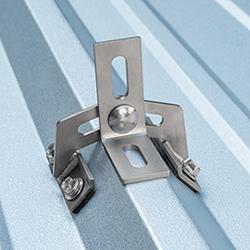Supercapacitors Hailed as Potential Answer to Greener Public Transportation
Drexel University Materials Professor Gogotsi Touts New Technology
Imagine a bus that uses electrical storage that costs much less than traditional batteries, can fully charge each time the bus stops, and has enough power to easily get to the next stop. The supercapacitor, once used to power robots and as a backup power source for computer memory, is now being hailed as such an energy source that could be the key to greener public transportation.
In an article written by well-known science writer Philip Ball for the Energy Quarterly feature of MRS Bulletin, researcher Yury Gogotsi posits that the supercapacitor has the potential to become a big player in the global search for reliable green energy. This is particularly true for transportation, based on experience with the use of supercapacitors in Germany.
Supercapacitors are allowing trams in Mannheim, Germany, to use 30% less energy than their equivalents in other cities. In a recent 24-hour speed race at Le Mans, Toyota put their faith in a hybrid TS030 car that used "supercaps" for energy-capture during braking. In China, supercapacitor technology has been embraced so fervently over just the past four years that tens of thousands of supercap buses are now on the roads.
So what are supercapacitors and just what do they bring to the power party? Gogotsi, professor of materials science and engineering at Drexel University in Philadelphia, explains supercapacitors as power-storage devices that can supply onboard electrical power in hybrid vehicles. Whereas batteries store energy in chemical form-in substances that can react to release electrical energy-capacitors store it by simply piling up electrical charge on two electrodes. The larger the electrodes and the closer they are, the more energy can be stored.
Unlike batteries, supercapacitors can be charged and discharged in seconds and can withstand many hundreds of thousands of such charging cycles. This is ideal for energy-saving applications that capitalize on transient opportunities for recharging, such as energy capture during braking, and other actions that require power to be delivered in short bursts. They can help with acceleration, restart engines that cut out, drive air conditioning, and power automatic windows and passenger doors. In some aircraft, they are entrusted with powering emergency actuation systems for doors and evacuation slides.
Supercapacitor technology is now deployed on Spanish and French trains and hybrid buses all over the world, on construction equipment such as cranes, and on garbage-collection trucks in the US. On buses, it can reduce carbon-dioxide emissions by around 30%. The Munich-based heavy-vehicle manufacturer MAN estimates that their supercapacitor-fitted coaches each save around $4,500 a year on fuel costs.
The take-up of the technology looks set to expand, as both energy-saving and low-emission technologies become more necessary and as the technical capabilities of supercapacitors improve.
"There is no single perfect energy-storage solution, no 'one size fits all,'" said Gogotsi. "A 'battery of the future' may well be a battery-supercapacitor hybrid which combines the long lifetime, fast charging, and high power of a supercapacitor with the high energy density of a battery."
With a huge variety of potential uses, supercapacitors are one of the few electronic components that have had a steadily growing market over recent years with rapid growth widely expected.
A copy of the article can be found at journals.cambridge.org/MRSEQ201209.
MRS Bulletin is one of the most widely recognized and highly respected publications in advanced materials research. Published monthly, it features technical theme topics that capture a snapshot of the state-of-the-art of materials research. Written by leading experts, the overview articles are useful references for specialists but are also presented at a level understandable to a broad scientific audience.
Energy Quarterly (EQ) is a special section published in the March, June, September, and December issues of MRS Bulletin dedicated to the challenges facing materials scientists in the quest for sustainable solutions to the world's energy problems.
For further information, go to: www.mrs.org/energy-quarterly.
About the Materials Research Society
The Materials Research Society (MRS) is an international organization of almost 16,000 materials researchers from academia, industry and government, and a recognized leader in promoting the advancement of interdisciplinary materials research to improve the quality of life. MRS members are engaged and enthusiastic professionals hailing from physics, chemistry, biology, mathematics and engineering-the full spectrum of materials research.
Headquartered in Warrendale, Pennsylvania (USA), MRS membership now spans over 80 countries, with more than 40% of members residing outside the United States. In addition to its communications and publications portfolio, MRS organizes high-quality scientific meetings, attracting over 13,000 attendees annually and facilitating interactions among a wide range of experts from the cutting edge of the global materials community. MRS is also a recognized leader in education outreach and advocacy for scientific research.
For further information, go to: www.mrs.org.
About Cambridge Journals
Cambridge University Press publishes over 300 peer-reviewed academic journals across a wide spread of subject areas, in print and online. Many of these journals are the leading academic publications in their fields and together they form one of the most valuable and comprehensive bodies of research available today.
For further information, go to: journals.cambridge.org.
Featured Product

QuickBOLT - QB RibRider: Flexible, Fast, and Secure Solar Mounting for Metal Roofs
The QB RibRider™ is an adjustable and easy-to-place mount for exposed fastener and trapezoidal ribbed roofs, combining versatility with robust construction. It features a 90/180 mounting combo with 75mm butyl pads on the base for superior weatherproofing. The RibRider is designed to fit most exposed fastener, trapezoidal, and ribbed metal roof profiles. This mount features stainless steel roof brackets and comes with four #14 x 1-1/4" hex washer self-drilling screws, ensuring a secure attachment to the roof.
